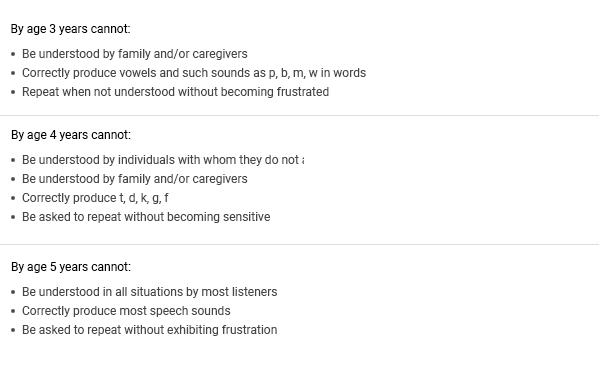Developmental Norms
Each child is an individual and therefore his/her respective speech and language development may differ slightly from his/her peers. However, there are developmental norms and generalities regarding what skills are expected to develop at specific ages. Following is a general outline of the different ages and developmental stages that are expected from children from birth to age five.
It is important to note that if your child is not performing 1-2 skills in a particular age range it may be an indicative of possible delayed hearing, speech, and/or language development. If your child is not performing 3 or more of the skills listed in a particular age range, it is imperative to take action and contact a Speech-Language Pathologist to find out if an evaluation or consultation is necessary. Additionally, included below is a compilation of common warning signs of a communication disorder. Please note that these lists are not all inclusive.
Furthermore, it is important to bear in mind that these developmental norms apply to monolingual children (children who speak one language). The norms for bilingual children (children who speak two languages) may differ due to the impact of the primary language, nationality, ethnicity, and culture.
What should my child be able to do?
Click image for larger chart
*Chart compiled from www.asha.org http://www.asha.org/public/speech/development/chart "How Does Your Child Hear and Talk?"
Common “red flags”:
Click image for larger chart
*Chart compiled from www.asha.org http://www.asha.org/public/speech/speech-referral “Behaviors that should trigger an SLP referral”
Speech referral guidelines for pediatrics from the American Speech Hearing Association (ASHA):
Most Common Etiologies
- Cerebral palsy
- Craniofacial disorders (e.g., cleft lip/palate)
- Functional articulation and/or phonological disorders
Potential Consequences/Impact of Speech Impairment Can Include
- Difficulty expressing need or routine information intelligibly
- Difficulty communicating intelligibly in order to function at level of independence expected for age
- Difficulty expressing feelings intelligibly; may be at risk for frustration or depression
- Difficulty engaging successfully in social and/or classroom situations that require intelligible speech
- Difficulty achieving adequate intelligible speech to reach educational potential
- At risk for personal injury due to difficulty communicating intelligibly about a dangerous situation or calling for help
Behaviors that should trigger an SLP referral
By age 3 years cannot:
- be understood by family and/or caregivers
- correctly produce vowels and such sounds as p, b, m, w in words
- repeat when not understood without becoming frustrated
By age 4 years cannot:
- be understood by individuals with whom they do not associate regularly
- be understood by family and/or caregivers
- correctly produce t, d, k, g, f
- be asked to repeat without becoming sensitive
By age 5 years cannot:
- be understood in all situations by most listeners
- correctly produce most speech sounds
- be asked to repeat without exhibiting frustration
Disturbance in neuromuscular control causes difficulty learning to produce sounds appropriately
- speech is usually slurred; difficulty controlling respiration for speech; abnormal loudness, rhythm, or vocal quality
- exhibits difficulty learning sounds to form words; may sound nasal, strangled and/or breathy
- exhibits frustration and/or avoidance of speech due to extreme difficulty forming sounds or difficulty being understood
Disturbance in programming, positioning, and sequencing of muscular movements
- sound errors are prevalent but variable (i.e., "dog" could be produced "dog," "tog," "gog," "god" by same child)
- varies from rarely being able to produce sounds to ongoing speech that is rarely understood, or speech that is usually understood with frequent sound errors
- unaware of sound variations or exhibits varying degrees of frustration and/or anxiety regarding inability to "control speech"
Disturbance in performing voluntary movements with mouth and vocal mechanism
- cannot produce movements for sound production or sounds are produced without voice (whispered speech)
- varies from inability to produce any words to extreme difficulty being understood
- exhibits frustration and/or avoidance of speech due to difficulties
Deafness/severe hearing loss causes severe prosodic disturbances in intonation, duration, and rhythm in addition to sound errors
- produces no meaningful words or sounds understood only by family
- speaks loudly in high pitched voice with frequent distortion, omission, and substitution of sounds
Autism, emotional disturbance, and/or mental retardation may cause very unusual prosodic variations
- intonation and/or rhythm of connected speech may sound abnormal
- volume may be consistently or intermittently too loud or too soft
Deviation in structure of speech mechanism
- difficulty producing specific sounds and intelligible speech
- exhibits frustration and/or avoidance of speech
- speech has excessive nasality
Difficulty in hearing and/or inability to differentiate between sounds inhibit child's ability to detect and correct error sounds; usually unaware of errors
Intelligibility and sound production are compromised when nasal passages, nasopharynx, and larynx are bypassed due to tracheostomy/ventilator dependence
Exhibits sudden decrease in speech intelligibility
- ranges from slurred, generally intelligible speech to total absence of speech, or totally unintelligible speech
- awareness ranges from extremely aware to totally unaware of sound errors
Exhibits decline in ability to be understood by family, friends, and/or caregivers in the expression of basic needs, preferences, and feelings
For more information about UpWords Therapy click here, email us or give us a call at 732-364-8796


